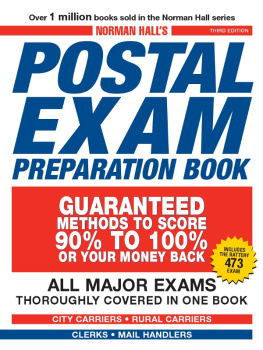
 Copyright 2007 by The McGraw-Hill Companies, Inc. All rights reserved. Except as permitted under the United States Copyright Act of 1976, no part of this publication may be reproduced or distributed in any form or by any means, or stored in a database or retrieval system, without the prior written permission of the publisher. ISBN: 978-0-07-171216-3
Copyright 2007 by The McGraw-Hill Companies, Inc. All rights reserved. Except as permitted under the United States Copyright Act of 1976, no part of this publication may be reproduced or distributed in any form or by any means, or stored in a database or retrieval system, without the prior written permission of the publisher. ISBN: 978-0-07-171216-3
MHID: 0-07-171216-X The material in this eBook also appears in the print version of this title: ISBN: 978-0-07-147509-9, MHID: 0-07-147509-5. All trademarks are trademarks of their respective owners. Rather than put a trademark symbol after every occurrence of a trademarked name, we use names in an editorial fashion only, and to the benefit of the trademark owner, with no intention of infringement of the trademark.
Where such designations appear in this book, they have been printed with initial caps. McGraw-Hill eBooks are available at special quantity discounts to use as premiums and sales promotions, or for use in corporate training programs. To contact a representative please e-mail us at bulksales@mcgraw-hill.com. TERMS OF USE This is a copyrighted work and The McGraw-Hill Companies, Inc. (McGraw-Hill) and its licensors reserve all rights in and to the work. Use of this work is subject to these terms.
Except as permitted under the Copyright Act of 1976 and the right to store and retrieve one copy of the work, you may not decompile, disassemble, reverse engineer, reproduce, modify, create derivative works based upon, transmit, distribute, disseminate, sell, publish or sublicense the work or any part of it without McGraw-Hills prior consent. You may use the work for your own noncommercial and personal use; any other use of the work is strictly prohibited. Your right to use the work may be terminated if you fail to comply with these terms. THE WORK IS PROVIDED AS IS. McGRAW-HILL AND ITS LICENSORS MAKE NO GUARANTEES OR WARRANTIES AS TO THE ACCURACY, ADEQUACY OR COMPLETENESS OF OR RESULTS TO BE OBTAINED FROM USING THE WORK, INCLUDING ANY INFORMATION THAT CAN BE ACCESSED THROUGH THE WORK VIA HYPERLINK OR OTHERWISE, AND EXPRESSLY DISCLAIM ANY WARRANTY, EXPRESS OR IMPLIED, INCLUDING BUT NOT LIMITED TO IMPLIED WARRANTIES OF MERCHANTABILITY OR FITNESS FOR A PARTICULAR PURPOSE. McGraw-Hill and its licensors do not warrant or guarantee that the functions contained in the work will meet your requirements or that its operation will be uninterrupted or error free.
Neither McGraw-Hill nor its licensors shall be liable to you or anyone else for any inaccuracy, error or omission, regardless of cause, in the work or for any damages resulting therefrom. McGraw-Hill has no responsibility for the content of any information accessed through the work. Under no circumstances shall McGraw-Hill and/or its licensors be liable for any indirect, incidental, special, punitive, consequential or similar damages that result from the use of or inability to use the work, even if any of them has been advised of the possibility of such damages. This limitation of liability shall apply to any claim or cause whatsoever whether such claim or cause arises in contract, tort or otherwise.
CONTENTS
How to Use This Book
This book is designed primarily to help those who are interested in employment with the U.S. Postal Service learn about available jobs and their requirements, and, in particular, to learn about Test 473, the test required for most positions.
Specific strategies and practice drills and exams are provided to help you do well on the examand succeed in gaining employment with the U.S. Postal Service. Here are a few hints on how to best start using this book. First, read to learn about jobs in the U.S. Postal Service and how to apply for them. Second, learn all about Test 473its organization, types of questions, scoring, and so on.
Then, equipped with this basic general knowledge, learn more about each of the four main sections of Test 473 by reading (and studying) . Each of these chapters discusses the types of questions included in one part of the test and provides both specific tips for answering the questions and general strategies to use when working on that particular section. Practice drills help to ensure that you understand how to answer the questions in each section. Finally, take a practice test, or maybe two tests. Score them and determine what your weak points are: Address Checking, Forms Completion, or Coding and Memory. Then go back to the chapter that discusses that particular part of the test and review the material to be sure you know exactly what the questions are asking and what approaches you should take in attempting to answer them correctly.
Then, take another practice test and repeat the procedure. By the time you have completed several practice testsseven are given in this bookyou should be very familiar with the test and well on your way to scoring well. Good luck.
PART 1
USPS JOBS AND TAKING TEST 473
CHAPTER 1
Working for the U.S. Postal Service in Entry-Level Jobs
Eligibility, Requirements, and Benefits
The U.S. Postal Service (USPS) is one of the nations largest civilian employers, currently employing more than 700,000 people in career positions throughout the country.
A career position with the Postal Service can be rewarding work: the compensation and benefits packages are among the best youll find anywhere, and youll enjoy the additional satisfaction of knowing that you are part of a long tradition of providing vital services to the country and its people. Understandably, Postal Service employment is attractive to many, many people, and the market for Postal Service career jobs is very competitive. Application exams such as Test 473 are one means that the Postal Service uses to screen applicants and identify those who are best qualified for various positions. Test 473 is officially known as Test 473 for Major Entry-Level Jobs and is also referred to as the 473 Battery Exam. (It replaces the old 470 Battery Exam.) If youre applying for a job that requires you to take one of the exams given by the Postal Service, its imperative that you gain a competitive edge by preparing thoroughly for the exam. This is especially true for Test 473 because more applicants take this exam than any of the other Postal Service exams.
Thats why weve created a book dedicated almost entirely to helping you do just that. The official U.S. postal system was created during the American Revolution, primarily to facilitate the delivery of important messages among various divisions of the Revolutionary army. Meeting in July of 1775, the Second Continental Congress named Benjamin Franklin, who had been instrumental in devising the systems framework and recommending it to the Congress, as the postal systems initial Postmaster General. Before we examine the test itself in , lets take a look at the various career jobs with the Postal Service. All of these career jobs require applicants to take either Test 473 or another test.
A bit later in this chapter, youll learn about the specific employment benefits offered by the Postal Service and the eligibility requirements for career employment with the Postal Service.
Postal Jobs Requiring Test 473 Scores
Applicants for most types of delivery, distribution, and retail jobs with the USPS must take Test 473 (or Test 473-C for City Carriers). There are four positions that fall into this category:
 Next page
Next page





 Copyright 2007 by The McGraw-Hill Companies, Inc. All rights reserved. Except as permitted under the United States Copyright Act of 1976, no part of this publication may be reproduced or distributed in any form or by any means, or stored in a database or retrieval system, without the prior written permission of the publisher. ISBN: 978-0-07-171216-3
Copyright 2007 by The McGraw-Hill Companies, Inc. All rights reserved. Except as permitted under the United States Copyright Act of 1976, no part of this publication may be reproduced or distributed in any form or by any means, or stored in a database or retrieval system, without the prior written permission of the publisher. ISBN: 978-0-07-171216-3